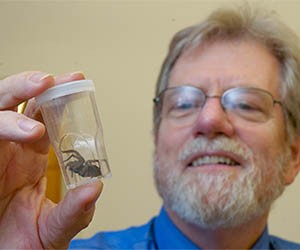
We Shouldn t Fear the Big, Bad Wolf (Spider, That Is)
Longtime University of Cincinnati professor George Uetz studies how the environment influences the evolution of behavior through researching animal behavior and ecology. Uetzs research focuses on spiders, in particular wolf spiders and colonial web-building spiders.
Although many psychologists disagree on whether human fear of spiders is innate or learned, Uetz argues that there is nothing to fear about these creatures. He explains that this fear is mostly perpetuated as a consequence of misinformation, especially nowadays via the Internet.
Spiders are mostly harmless and bite people far less frequently than suspected, Uetz explained. Indeed, one study showed more than 80 percent of physician-diagnosed Brown Recluse spider bites are likely something else.
Uetz believes that researching and understanding the natural world can help us achieve advances in areas that contribute to economic growth, such as human health and medicine, environmental quality and conservation of natural resources, agriculture and forestry.
Spiders not only play a huge role in nature, but also can also help contribute to a number of economic enterprises.
For example, there is spider silk that is stronger than steel and spider venom that is used in the pharmaceutical industry. Additionally, there are spiders used as a biological control of pests in agricultural crops as well as spider-inspired biomimetic robotics.
The National Science Foundation helps fund Uetzs most recent research, which focuses on the Brush-legged wolf spider,
Schizocosa ocreata.
In particular, he researches how these spiders communicate using different sensory modes: visual, vibratory and chemical.

Male schizocosa ocreata
In his research, Uetz also examines how aspects of the physical environment influence the evolution of signals sent by male spiders and received by female spiders. Some of the observed characteristics include moisture in the environment, the light spectrum and the structure of substrate.
In the case of the wolf spiders I work on, Uetz said, they are very abundant in deciduous forests and are an important component of the forest floor in local woods.
Another type of
was recently found in Adams County at a nature preserve run by the Cincinnati Museum Center and the Nature Conservancy. The
Hogna carolinensis,
or the Carolina wolf spider, is the biggest wolf spider in America and had not been seen in Ohio for more than 60 years. Because the two types of spiders occur in the same area, it is likely that the Carolina wolf spider would prey upon the smaller
Schizocosa ocreata
.
Throughout his time at UC, Uetz has been sharing his knowledge regarding these spiders with the 39 graduate and 150 undergraduate students who have participated in his research over the years.
Related Stories
Meet UC’s Miss Ohio
July 1, 2024
UC biomedical science student Stephanie Finoti credits UC for helping to prepare her for the Miss Ohio Scholarship Pageant. She will represent Ohio in the national competition in January.
UC alum credits journalism program with early success
June 26, 2024
Zachary Jarrell came to the University of Cincinnati in 2019 to pursue a degree in statistics. In 2023, he graduated with a Bachelor’s in Journalism. For many undergraduates, the journey through college rarely takes the expected track. Detours happen, and majors change. When plans switch up, it can be helpful to a student’s success to find support. For Jarrell, it was the people he worked alongside in the journalism department who helped him on his journey. It has left a lasting impression on his life so far, guiding him to multiple internships as an undergraduate, real-world experience in prominent news outlets, and eventually a successful career in the highly competitive field of journalism.
The health impact of living near a natural gas leak
June 25, 2024
UC College of Arts and Sciences Professor Amy Townsend-Small talks to the BBC about the health issues faced by neighbors of leaking natural gas wells.
